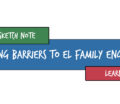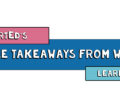
Note: This post first appeared on k-12talk.com September 24, 2019. That piece is titled Back to School: Promoting ELs’ Assets.
The proportion of English learners (ELs) in the United States public school system has reached nearly ten percent of all students and is on a nationwide growth trajectory¹. Along with this growth in numbers, ELs tend to experience an opportunity gap, which generally refers to the impact that factors such as students’ English proficiency, socioeconomic status, race, and ethnicity have on their achievement. For example, 79% of English fluent eighth graders scored at the basic or above reading level in 2017, while only 32% of ELs scored at those levels during that same year². In addition, ELs have one of the lowest graduation rates among all students on a national level, approximately 63% as compared to 82% of all students³. Gaps such as these have helped lead far too many educators to see ELs as one-dimensional, defined primarily as lacking in areas such as English proficiency, achievement in content areas, and/or ability to graduate. Recent research⁴ on teachers’ perceptions of ELs in kindergarten through second grade suggests that classifying students as ELs has a “direct and negative effect on teachers’ perceptions of students’ academic skills.”
That’s a lot of bad news, right? It doesn’t need to be that way, however.
In this blog post, I hope to raise your awareness about the importance of recognizing the multiple assets that our ELs bring.
An assets-based perspective values students’ home languages and cultures and sees these gifts as foundations for future learning, rather than as hindrances to overcome. An assets-based perspective also recognizes that parents of ELs are involved in their children’s education and support their children in varied and perhaps unrecognized ways⁵, rather than blaming them for their children’s perceived lack of academic skills. It also provides multiple opportunities to honor students’ cultural and linguistic backgrounds and incorporate what students already know into their learning. Thus, it stands in direct contrast to a deficit perspective, in which the focus is on ELs’ challenges.
The good news? Despite systems which may impede ELs’ assets to be recognized, individual teachers possess the agency to chip away at the deficit perspective.
![]()
Three Strategies for Promoting English Learners’ Assets
Engaging in an assets-based approach with ELs requires a shift in our thinking from what we believe is lacking in our students to the many strengths and assets ELs and their families already possess. To do this, we must take time to learn about our ELs’ and their families’ invaluable personal, cultural, social, and world experiences and draw from these strengths-based understandings to create instructional opportunities that are meaningful, purposeful and appealing to students. Not only will our ELs benefit, but English-fluent students will learn from their EL peers and see them in a new light. Here are three replicable ways to promote ELs’ assets.–
1. Encourage Storytelling.
 We all love to hear a good story, and ELs sharing their own stories is one way we can build bridges and help foster connections with EL students. Teachers of younger ELs can first model the task of students drawing a personal narrative storyboard or series of images⁶, then have students write a response to the sentence prompt—“What I wish my teacher knew about me.” Teachers can ask older newcomer students to write a personal narrative and then share it with colleagues and school administrators.
We all love to hear a good story, and ELs sharing their own stories is one way we can build bridges and help foster connections with EL students. Teachers of younger ELs can first model the task of students drawing a personal narrative storyboard or series of images⁶, then have students write a response to the sentence prompt—“What I wish my teacher knew about me.” Teachers can ask older newcomer students to write a personal narrative and then share it with colleagues and school administrators.
To begin this project, interview students and ask them to write about themselves in their home languages, offering scaffolding for these tasks. Each of these activities supports the process of learning more about students’ lives and experiences so that we, as educators, develop a better understanding of the linguistic and cultural assets that our students bring to our classrooms. One piece of advice: be sure to give EL students the choice to tell as much of their stories as they feel comfortable with or to have the option to not share them at all, as students may have experienced traumatic events that they wish not to share.
ELs and their families who are open to the idea could also publish their stories in school newspapers to reach a wider audience. Artwork can provide an alternative way for students to contribute their stories. (For more on this topic, please see Zacarian & Staehr Fenner’s chapter “From Deficit-Based to Assets-Based” in Breaking Down the Wall: Essential Shifts for English Learners’ Success.)
–
 –––––––––––––––––––––––––––––––––––––––––––––––––––––––––––––––––––––––––––––––––––––
–––––––––––––––––––––––––––––––––––––––––––––––––––––––––––––––––––––––––––––––––––––
–
➤ Self-paced. Available year-round. Earn a certificate for 20 PD hours by joining our Culturally
—–Responsive Teaching for Multilingual Learners (MLs) on-demand book study at any time.
–
–––––––––––––––––––––––––––––––––––––––––––––––––––––––––––––––––––––––––––––––––––––
–
––
2. Spread the Word About ELs’ Success.
 To disrupt deficit thinking, I also encourage you to share news of ELs’ successes – both great and small – with your school or district. There are many examples, if we are more aware of where to find them, of ways to demonstrate ELs’ growth academically or personally. For instance, I love reading each spring about current or former ELs who have become high school valedictorians. These success stories highlight the metalinguistic superpowers ELs develop (not to mention hard work and persistence) as they learn content in a new language.
To disrupt deficit thinking, I also encourage you to share news of ELs’ successes – both great and small – with your school or district. There are many examples, if we are more aware of where to find them, of ways to demonstrate ELs’ growth academically or personally. For instance, I love reading each spring about current or former ELs who have become high school valedictorians. These success stories highlight the metalinguistic superpowers ELs develop (not to mention hard work and persistence) as they learn content in a new language.
You can also invite successful former ELs – including those in college, receiving technical training, or in careers – back to your school in person or by video to highlight what helped them achieve. I encourage you to investigate multiple ways to disseminate your message, such as in assemblies, local newspapers, and/or on your school or district’s social media channels (with students’ and families’ permission).
–
–
3. Thoughtfully Confront the EL Deficit Mindset.
Once your awareness of the importance of promoting an assets-based perspective of ELs is raised, you may begin to notice when others make deficit-based statements about ELs. This gives you the opportunity to support a colleague’s shift from a deficit to an assets-based disposition⁷.
We need to be thoughtful about challenging others’ thinking in order to do so without disrupting our crucial relationships with our colleagues, especially those relationships that are formed in a new school year. All educators – no matter what their title or how many years of experience they have – are positioned to serve as agents of change when it comes to helping others shift ever so slightly to an assets-based view of ELs and their families.
But how can we best challenge others’ deficit thinking when we find ourselves in the uncomfortable space in which we hear someone apply a deficit perspective in describing an EL or an EL’s family?
–
When you encounter such a situation, I suggest following these steps⁸:
1. Recognize and acknowledge your colleague’s expertise.
2. First listen and try to understand your colleague’s perspective, even if you may not agree with them.
3. Consider what might be happening on a systematic level to promote EL deficit thinking around this issue.
4. Suggest some potential strategies to them to better support their ELs.
5. Lighten their load by offering to help implement a new strategy or approach to support them in their work with ELs.
6. Follow up on your support for ELs by checking back in with them.
We all have the ability to spread a culture of EL assets in our sphere of influence. If you begin the school year with ELs’ assets in mind, you and your colleagues will be better positioned to create a more welcoming environment for our ELs who have so much to contribute and offer. (For more on this topic, please see Zacarian & Staehr Fenner’s chapter “From Deficit-Based to Assets-Based” in Breaking Down the Wall: Essential Shifts for English Learners’ Success.)
—
 –––––––––––––––––––––––––––––––––––––––––––––––––––––––––––––––––
–––––––––––––––––––––––––––––––––––––––––––––––––––––––––––––––––
–
➤ Earn a certificate for 1-3 PD hours in our Supporting ELs’ Pathways
—–to Graduation on-demand course. Self-paced & available year-round.
–
–––––––––––––––––––––––––––––––––––––––––––––––––––––––––––––––––
–
![]()
Three Strategies for Promoting ELs’ Assets Sketch Note
We encourage you to share this blog post and sketch note with colleagues to continue fostering a shared sense of accountability in the shift from a deficit to an assets-based disposition. You can click here to share our blog post and sketch note on Twitter, or click here to download this sketch note immediately.

Click here to download the Three Strategies for Promoting English Learners’ Assets Sketch Note
![]()
Sources:
¹ National Center for Education Statistics. (2019). English language learners in public schools. Retrieved from https://nces.ed.gov/programs/coe/indicator_cgf.asp
² National Center for Education Statistics. (2017). The Nation’s Report Card. (2017). NAEP reading report card. Retrieved from https://www.nationsreportcard.gov/reading_2017/#/nation/achievement?grade=8
³ National Clearinghouse for English Language Acquisition. (2018). National- and State-Level High School Graduation Rates for English Learners. Retrieved from https://ncela.ed.gov/files/fast_facts/OELA_FF_HS_GradRates.pdf
⁴ Umansky, I, & Dumont, H. (2019). English Learner Labeling: How English Learner Status Shapes Teacher Perceptions of Student Skills & the Moderating Role of Bilingual Instructional Settings. (EdWorkingPaper: 19-94). Retrieved from Annenberg Institute at Brown University: http://www.edworkingpapers.com/ai19-94
⁵ Staehr Fenner, D. (2014). Advocating for English learners: A guide for educators. Thousand Oaks, CA: Corwin.
⁶ Zacarian, D., & Staehr Fenner, D., “From Deficit-Based to Assets-Based” (2020). In Calderón, M. et al., Breaking down the wall: Essential shifts for English learners’ success. Thousand Oaks, CA: Corwin.
⁷ Zacarian, D., & Staehr Fenner, D., “From Deficit-Based to Assets-Based” (2020). In Calderón, M. et al., Breaking down the wall: Essential shifts for English learners’ success. Thousand Oaks, CA: Corwin.
⁸ Adapted from a 2017 blog post by Diane Staehr Fenner on SupportEd: https://supported.com/supporteds-top-10-ways-support-english-learners-2017
![]()
Continue the conversation with us on Twitter: @SupportEduc
Additional resources: 2021 Online PD Offerings | Free Checklists & Tools | Webinar Replays



